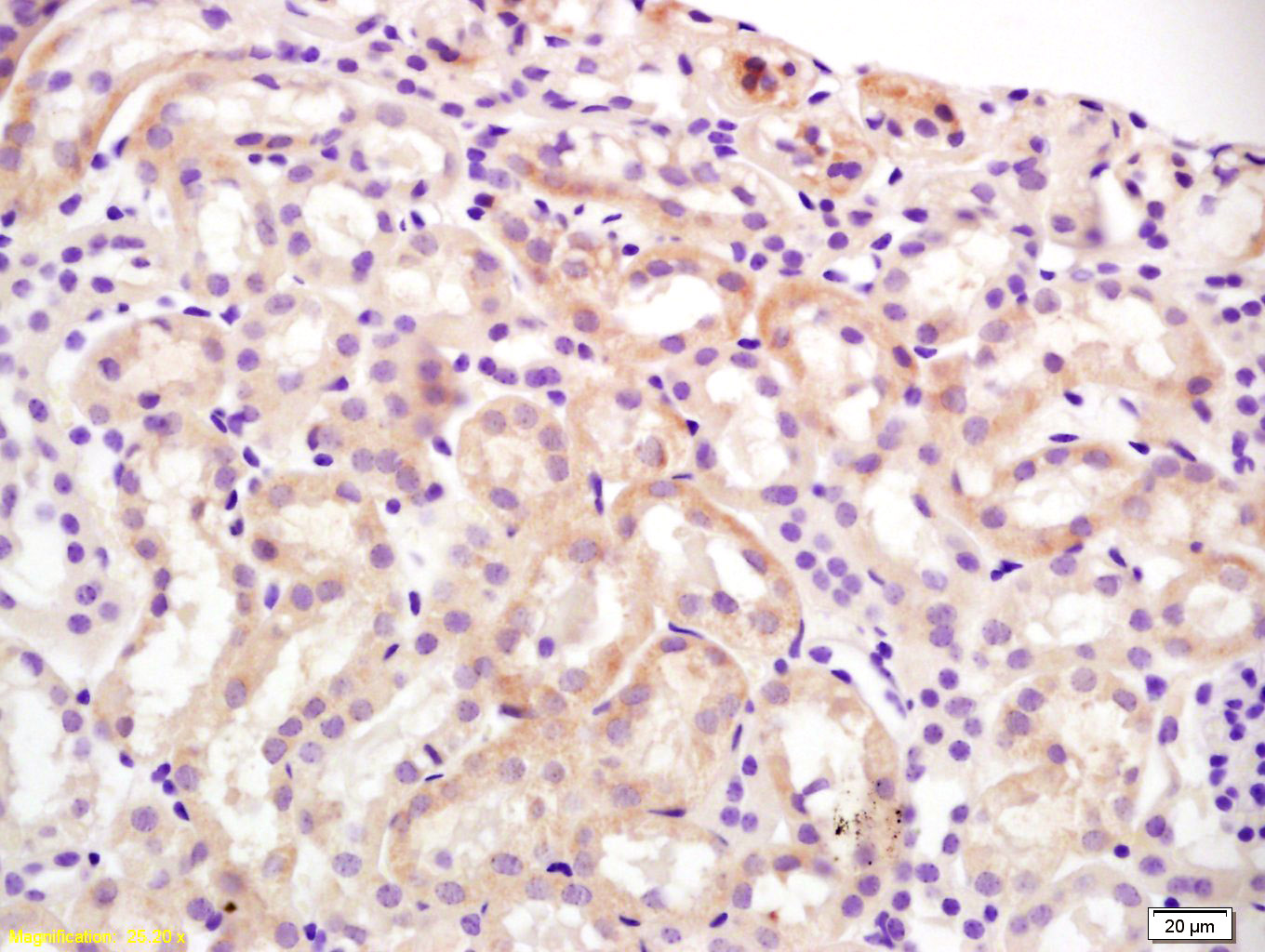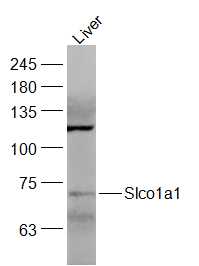Slco1a1 Rabbit pAb
Slco1a1 Rabbit pAb
- SPECIFICATION
- CITATIONS
- PROTOCOLS
- BACKGROUND

Application
| WB, IHC-P, IHC-F, IF |
|---|---|
| Primary Accession | P46720 |
| Reactivity | Rat |
| Host | Rabbit |
| Clonality | Polyclonal |
| Calculated MW | 74 KDa |
| Physical State | Liquid |
| Immunogen | KLH conjugated synthetic peptide derived from rat Slco1a1 |
| Epitope Specificity | 2-90/670 |
| Isotype | IgG |
| Purity | affinity purified by Protein A |
| Buffer | 0.01M TBS (pH7.4) with 1% BSA, 0.02% Proclin300 and 50% Glycerol. |
| SUBCELLULAR LOCATION | Basolateral cell membrane |
| SIMILARITY | Belongs to the organo anion transporter (TC 2.A.60) family. [SIMILARITY] Contains 1 Kazal-like domain. |
| SUBUNIT | Binds to PDZK1. Interaction with PDZK1 is required for expression on hepatocyte surface. |
| Post-translational modifications | Glycosylated. |
| Important Note | This product as supplied is intended for research use only, not for use in human, therapeutic or diagnostic applications. |
| Background Descriptions | mediates the transport of sulfated, amidated bile acid, sulfolithocholyltaurine, into rat hepatocytes |
| Gene ID | 50572 |
|---|---|
| Other Names | Solute carrier organic anion transporter family member 1A1, Organic anion-transporting polypeptide 1, OATP-1, Sodium-independent organic anion transporter 1, Solute carrier family 21 member 1, Slco1a1 {ECO:0000312|RGD:3700} |
| Target/Specificity | Highly expressed in liver and kidney, and at lower levels in brain, lung, skeletal muscle and proximal colon. |
| Dilution | WB=1:500-2000,IHC-P=1:100-500,IHC-F=1:100-500,IF=1:100-500 |
| Format | 0.01M TBS(pH7.4), 0.09% (W/V) sodium azide and 50% Glyce |
| Storage | Store at -20 ℃ for one year. Avoid repeated freeze/thaw cycles. When reconstituted in sterile pH 7.4 0.01M PBS or diluent of antibody the antibody is stable for at least two weeks at 2-4 ℃. |
| Name | Slco1a1 {ECO:0000312|RGD:3700} |
|---|---|
| Function | Mediates the Na(+)-independent transport of organic anions such as steroid sulfate conjugates (dehydroepiandrosterone sulfate (DHEAS), 17-beta-glucuronosyl estradiol, estrone-3-sulfate), conjugated (taurocholate) and unconjugated (cholate) bile acids, prostaglandin E2 (PGE2) and L-thyroxine T4 (PubMed:19129463). Also capable of transporting sulfobromophthalein (BSP), ouabain and gadoxetate (By similarity). Hydrogencarbonate/HCO3(-) acts as the probable counteranion that exchanges for organic anions (PubMed:19129463). Shows a pH-sensitive substrate specificity which may be ascribed to the protonation state of the binding site and leads to a stimulation of substrate transport in an acidic microenvironment (PubMed:19129463). |
| Cellular Location | Basolateral cell membrane; Multi-pass membrane protein |
| Tissue Location | Highly expressed in liver and kidney, and at lower levels in brain, lung, skeletal muscle and proximal colon |

Thousands of laboratories across the world have published research that depended on the performance of antibodies from Abcepta to advance their research. Check out links to articles that cite our products in major peer-reviewed journals, organized by research category.
info@abcepta.com, and receive a free "I Love Antibodies" mug.
Provided below are standard protocols that you may find useful for product applications.
Background
This product as supplied is intended for research use only, not for use in human, therapeutic or diagnostic applications.
If you have used an Abcepta product and would like to share how it has performed, please click on the "Submit Review" button and provide the requested information. Our staff will examine and post your review and contact you if needed.
If you have any additional inquiries please email technical services at tech@abcepta.com.













 Foundational characteristics of cancer include proliferation, angiogenesis, migration, evasion of apoptosis, and cellular immortality. Find key markers for these cellular processes and antibodies to detect them.
Foundational characteristics of cancer include proliferation, angiogenesis, migration, evasion of apoptosis, and cellular immortality. Find key markers for these cellular processes and antibodies to detect them. The SUMOplot™ Analysis Program predicts and scores sumoylation sites in your protein. SUMOylation is a post-translational modification involved in various cellular processes, such as nuclear-cytosolic transport, transcriptional regulation, apoptosis, protein stability, response to stress, and progression through the cell cycle.
The SUMOplot™ Analysis Program predicts and scores sumoylation sites in your protein. SUMOylation is a post-translational modification involved in various cellular processes, such as nuclear-cytosolic transport, transcriptional regulation, apoptosis, protein stability, response to stress, and progression through the cell cycle. The Autophagy Receptor Motif Plotter predicts and scores autophagy receptor binding sites in your protein. Identifying proteins connected to this pathway is critical to understanding the role of autophagy in physiological as well as pathological processes such as development, differentiation, neurodegenerative diseases, stress, infection, and cancer.
The Autophagy Receptor Motif Plotter predicts and scores autophagy receptor binding sites in your protein. Identifying proteins connected to this pathway is critical to understanding the role of autophagy in physiological as well as pathological processes such as development, differentiation, neurodegenerative diseases, stress, infection, and cancer.



